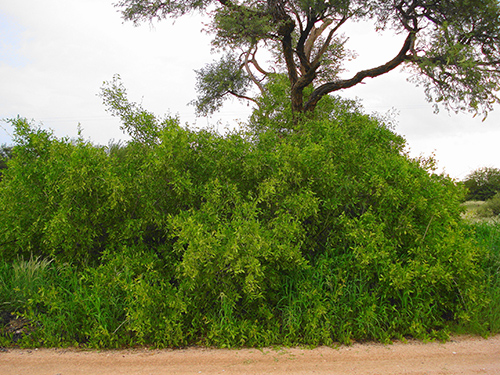• LUISE HOFFMANNTHIS scrambling shrub or small tree is easy to identify in the dry season because it always has bright green leaves.
It grows mainly in the northwestern parts of Namibia, e.g. in the vicinity of Twyfelfontein or near the waterhole Salvadora, named after this shrub. It is also found at other waterholes in Etosha such as Charitsaub, Khoinachas and in the caravan park in Namutoni as well as in all westward flowing watercourses as far south as the Kuiseb. Mustard bushes on the banks of the Khan River (photo) are quite visible from the bridge on the B2 just west of Usakos.
Names: G Löwenstrauch, Zahnbürstenbaum; A kerriebos; H omungambo; N-D khori, this being the origin of the place name Khorixas; Nd okatunduya, omumkavu; Ky enghadu
The mustard bush occurs widespread in many countries: China, India, Arabia, North Africa and along the Persian Gulf. The first specimen of this shrub to be formally described by the pharmacist Juan Salvador y Bosca (Barcelona, 1598-1681) came from Persia, hence the genus name Salvadora and the species name persica.
It usually is a rambling shrub or a small tree of 3 – 5m in height.
The brown bark of the trunk is slightly rough, young branches are green. Growing in opposite pairs and at right angles to each other, the leathery, elliptical to round leaves are bright green at all times of the year and they often have a peculiar smell.
Small greenish-yellow flowers are present throughout the year, while fruit can be found from August to May. The fruits are round, pea-sized berries, changing in colour from pink to red to brownish violet. They are edible but can cause diarrhoea. They taste sweetish and sharply aromatic because they contain benzyl mustard oil – hence the name ‘mustard tree’.
Notes: The leaves are browsed by livestock and the berries are fed to chickens. The berries also provide food for birds, insects, small mammals and even jackals as they are found on the plants for many months. The roots and branches of 3 – 5 mm thickness are chewed to clean teeth, gums and tongue.
They are said to relieve toothache, to remove plaque and to keep teeth and gums healthy. Research has shown that they contain several important minerals, substances that suppress the growth of bacteria and as much as 22 ppm fluoride. In the arid regions of India, according to sources on the Internet, chewing sticks of the mustard bush are known as “miswaks” and have been used for centuries to clean teeth.
The World Health Organisation recommends their use in areas where their use is customary. The Internet even advertises “6 Natural fresh moist vacuum-packed thin Miswaks” for sale. Also throughout Tanzania young stems 3 – 5 mm thick are sold in most major markets – a business idea for people in Namibia living in the vicinity of these plants.
Furthermore, in Namibia patients suffering from measles and similar rashes are rubbed with a mixture of crushed leaves and water. A root decoction is said to relieve stomach and intestinal pains and to cure diarrhoea not only in humans but also in livestock.
Stay informed with The Namibian – your source for credible journalism. Get in-depth reporting and opinions for
only N$85 a month. Invest in journalism, invest in democracy –
Subscribe Now!






